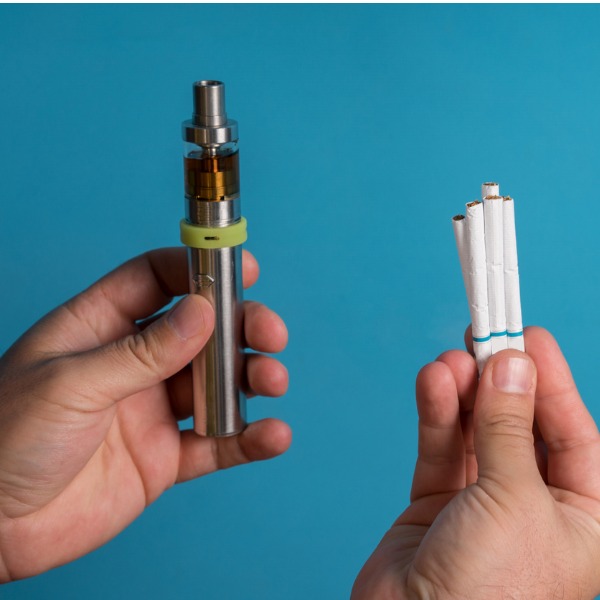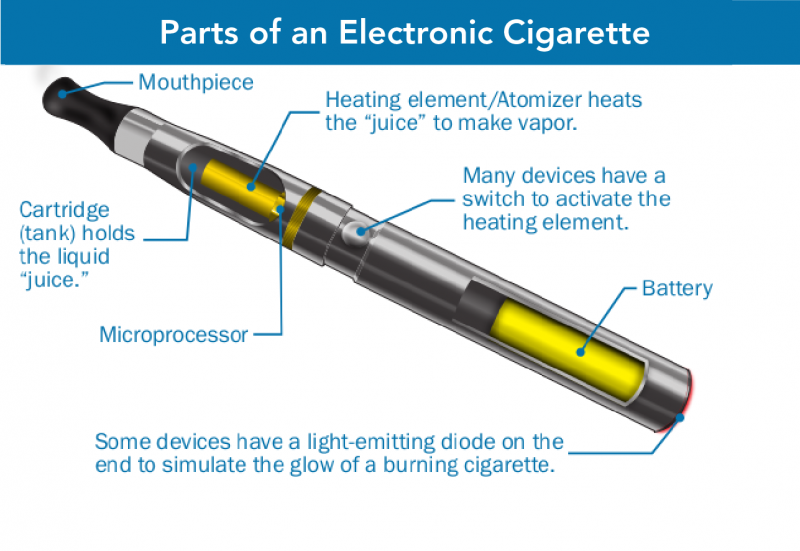Is Vaping Safer Than Smoking?

Electronic cigarette and traditional cigarettes (mustafagull, iStockphoto)

Electronic cigarette and traditional cigarettes (mustafagull, iStockphoto)
How does this align with my curriculum?
| Grade | Course | Topic |
|---|
Learn how e-cigarettes and other vaping products work, and why scientists and health professionals have concerns about their safety.
There's no denying that smoking is bad for your health. But what about vaping products such as electronic cigarettes? Unlike traditional cigarettes, vaping products don't contain any tobacco.They don't burn anything. They're marketed as a safer, healthier alternative to traditional cigarettes. But there isn’t much evidence available to back up this claim. In fact, there are serious health concerns related to vaping.
Did you know?
How does vaping work?
Vaping products come in different shapes. Some look like traditional cigarettes. Others look like pens. Some even look like USB sticks. Vaping products contain a cartridge which the user fills with a solution. This solution is sometimes called “vape juice” or “e-liquid.” The solution is made up of propylene glycol (C3H8O2) or glycerin (C3H8O3), nicotine (C10H14N2), and flavouring agents. When the person inhales, this activates a heating element. The heat turns the liquid solution into a vapour. The heat also sets off chemical reactions in the solution.

E-cigarette use went up a lot in Canada between 2015 and 2017. Approximately 22.8% of youth aged 15-19 have reported trying an e-cigarette at least once. However, only 6% reported regular (monthly) use.
Can you get addicted to vaping?
Vaping products may not contain tobacco. But most “vape juices” do still contain nicotine. That’s the addictive substance in cigarettes. A person can still get addicted to nicotine from vaping.That addiction can last a lifetime.
What are the other health concerns with vaping?
Many people think that vaping is healthier than smoking cigarettes. But scientists don’t actually know how safe e-cigarettes are. Vapourizers use solvents, such as propylene glycol, to dissolve the nicotine and flavouring. These solvents can also irritate the eyes, nose, throat, and lungs. They also break down and produce compounds containing a carbonyl group (C=O). Some carbonyl compounds (X-C=O) are known to cause cancer. For instance, when propylene glycol is heated and vapourized, it can produce the carcinogen propylene oxide (CH3CHCH2O).
Did you know?
Nicotine has negative effects on human brain development. Your brain continues to develop until you are in your 20s.
But do the substances in e-cigarette vapour get deposited in your body? Or do they just get exhaled along with the vapour? The answer lies in particle size. When you smoke an e-cigarette, you inhale an aerosol of ultra-fine particles. These very small nanoparticles are linked to many health problems. For example, they are linked to:
- lung inflammation
- asthma
- stroke
- heart disease
- diabetes
Also, bacteria exposed to nicotine-rich vapours form a biofilm coating. A biofilm is made up of a thick, glue-like substance. Microorganisms secrete biofilms to help themselves attach to a surface and to one another.These biofilm coatings can make bacteria more resistant to antibiotics. That means someone who vapes might have a harder time getting treated for illnesses like pneumonia.
Smoking and vaping have one other thing in common. Both can affect bystanders. Cigarettes produce second-hand smoke. Similarly, vapers exhale aerosol. This “passive vaping” could be a significant problem. Some places ban cigarette smoking but still allow vaping.
Health Canada recognizes that vaping can help smokers who are trying to quit. But it also warns against the other associated risks. Remember there is still little information about the long-term effects of vaping. That’s why Health Canada suggests avoiding vaping products altogether, especially if you are a young person who does not smoke cigarettes. Sound advice, because as they say: where there's smoke, there's fire.
Did you know?
STARTING POINTS
- Why do you think vaping is so popular with teens?
- Do you know anyone who vapes? If so, did the person previously smoke tobacco-based cigarettes?
- What do you think motivates teens to try vaping?
- Why do you think vaping has become so popular so quickly?
- Do you think that people are as aware of the health effects of vaping as they are of the health effects of smoking cigarettes? Why or why not?
- Should e-cigarettes be treated in the same way as regular cigarettes (e.g., banned from public spaces, restricted purchase by youth, etc.)? Explain.
- Describe the structures and properties of propylene glycol (C3H8O2), glycerin (C3H8O3) and nicotine (C10H14N2).
- Explain the short-term and long-term health effects of exposure to nicotine.
- Explain the difference between an aerosol and smoke.
- What types of evidence does a product need to back up its claims that it is safe to use? Does the e-cigarette technology meet the standards of evidence? Explain.
- Explain why the design and delivery systems of different brands of vaping products makes it difficult to provide reliable scientific data on the potential long-term effects of this product.
- It is sometimes said that people have a ‘moral right’ to self-abuse. That is, they have a right to engage in activities they know to be harmful as long as it does not impact others. Do you think this ‘moral right’ applies to vaping? Why or why not?
- Find an online ad for e-cigarettes. What sorts of phrases does it use to convince people that the product is a safer and healthier alternative to traditional tobacco-based cigarettes?
- Should vaping product ads provide the same sorts of health warnings as traditional tobacco-based cigarettes?
- What audiences do the makers of vaping products seem to be aiming their ads at? Should this be a concern?
- This article can be used to support teaching and learning of Health, Biology, and Chemistry related to smoking, bacteria, organic chemistry and cancer.
- After reading this article, teachers could have students consolidate learning by looking at the positive and negative aspects of vaping products over traditional cigarettes, using a Pros & Cons Organizer learning strategy. Download ready-to-use Pros & Cons Organizer reproducibles for the learning strategy for this article in [Google doc] and [PDF] formats.
- Alternately, teachers could have students make a decision regarding the safety of vaping products compared to other tobacco-based products, using a Think-Discuss-Decide learning strategy. Download ready-to-use Think-Discuss-Decide reproducibles for this article in [Google doc] and [PDF] formats.
- To go further, teachers could have students use a Consequence Mapping learning strategy to explore the potential consequences of the use of vaping products on the healthcare system. Download ready-to-use Consequence Mapping reproducibles for this article in [Google doc] and [PDF] formats.
Connecting and Relating
- Why do you think vaping is so popular with teens?
- Do you know anyone who vapes? If so, did the person previously smoke tobacco-based cigarettes?
- What do you think motivates teens to try vaping?
Relating Science and Technology to Society and the Environment
- Why do you think vaping has become so popular so quickly?
- Do you think that people are as aware of the health effects of vaping as they are of the health effects of smoking cigarettes? Why or why not?
- Should e-cigarettes be treated in the same way as regular cigarettes (e.g., banned from public spaces, restricted purchase by youth, etc.)? Explain.
Exploring Concepts
- Describe the structures and properties of propylene glycol (C3H8O2), glycerin (C3H8O3) and nicotine (C10H14N2).
- Explain the short-term and long-term health effects of exposure to nicotine.
- Explain the difference between an aerosol and smoke.
Nature of Science/Nature of Technology
- What types of evidence does a product need to back up its claims that it is safe to use? Does the e-cigarette technology meet the standards of evidence? Explain.
- Explain why the design and delivery systems of different brands of vaping products makes it difficult to provide reliable scientific data on the potential long-term effects of this product.
- It is sometimes said that people have a ‘moral right’ to self-abuse. That is, they have a right to engage in activities they know to be harmful as long as it does not impact others. Do you think this ‘moral right’ applies to vaping? Why or why not?
Media Literacy
- Find an online ad for e-cigarettes. What sorts of phrases does it use to convince people that the product is a safer and healthier alternative to traditional tobacco-based cigarettes?
- Should vaping product ads provide the same sorts of health warnings as traditional tobacco-based cigarettes?
- What audiences do the makers of vaping products seem to be aiming their ads at? Should this be a concern?
Teaching Suggestions
- This article can be used to support teaching and learning of Health, Biology, and Chemistry related to smoking, bacteria, organic chemistry and cancer.
- After reading this article, teachers could have students consolidate learning by looking at the positive and negative aspects of vaping products over traditional cigarettes, using a Pros & Cons Organizer learning strategy. Download ready-to-use Pros & Cons Organizer reproducibles for the learning strategy for this article in [Google doc] and [PDF] formats.
- Alternately, teachers could have students make a decision regarding the safety of vaping products compared to other tobacco-based products, using a Think-Discuss-Decide learning strategy. Download ready-to-use Think-Discuss-Decide reproducibles for this article in [Google doc] and [PDF] formats.
- To go further, teachers could have students use a Consequence Mapping learning strategy to explore the potential consequences of the use of vaping products on the healthcare system. Download ready-to-use Consequence Mapping reproducibles for this article in [Google doc] and [PDF] formats.
Learn more
Are E-Cigs Safer? (2013)
This video from Seeker (3:04 min.) discusses the differences between cigarette and e-cigarette smoking, and whether or not e-cigarettes are actually better than the alternative
Electronic Cigarettes: What's the Bottom Line?
This infographic from the CDC details the difference between cigarettes and e-cigarettes, and the risks associated with using e-cigarettes
Vaping and e-cigarette regulations across Canada (2016)
This article from CBC outlines e-cigarette regulations in the Canadian provinces and territories
References
Bjarnsholt, T. (2013, May 2). The role of bacterial biofilms in chronic infections, APMIS, 121(s136). DOI: 10.1111/apm.12099
Centers for Disease Control and Prevention. (2018, November 15). About Electronic Cigarettes (E-Cigarettes).
Government of Canada. (2019, March 7). Risks of vaping.
Kosmider, Leon, Sobczak, Andrzej, Fik, Maciej, . . . Lukasz, M. (2014). Carbonyl Compounds in Electronic Cigarette Vapors: Effects of Nicotine Solvent and Battery Output Voltage. Nicotine & Tobacco Research, 16(10). DOI: 10.1093/ntr/ntu078
Mulholland, A. (2014, April 22). E-cigarettes in regulatory grey zone: Are they banned or aren't they? CTV News.
Paddock, C. (2019, February 12). How safe are e-cigarettes? The debate continues (J. Collier, Ed.). Medical News Today.
Raloff, J. (2014, June 3). Health risks of e-cigarettes emerge. Science News.
Web MD. (2019, April 16). How Do E-Cigarettes Affect Your Body? (M. Ratini, Ed.).